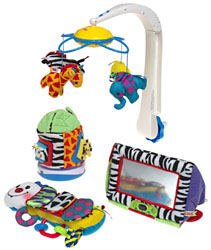Early Learning Toys
Awakening and rewarding developing abilities throughout the first year
 This great 4 pack is just what baby needs in it's first year. The Learning Patterns developmental system of toys is designed to help bring out your baby's full potential by awakening and rewarding developing abilities throughout the first year. The Flip Flop Caterpillar stimulates baby's sense of sight with its light-up nose, bright colors, bold patterns, and a special smile in the mirror. The Jungle Pal Music Mirror is designed to spark developing senses with delightful music and stimulating sights - like baby's own reflection. With its motorized color wheel, the Changing Sensations Mobile offers an intriguing display of gradually changing, high-contrast colors and patterns for baby to gaze at. The Learning Patterns Jungle Sounds Sorter offers baby plenty of jungle fun along with developmental benefits. Three cute shape sorting characters (lion, fish, zebra), bold colors and patterns, entertaining jungle music and lights add to the developmental fun.
This great 4 pack is just what baby needs in it's first year. The Learning Patterns developmental system of toys is designed to help bring out your baby's full potential by awakening and rewarding developing abilities throughout the first year. The Flip Flop Caterpillar stimulates baby's sense of sight with its light-up nose, bright colors, bold patterns, and a special smile in the mirror. The Jungle Pal Music Mirror is designed to spark developing senses with delightful music and stimulating sights - like baby's own reflection. With its motorized color wheel, the Changing Sensations Mobile offers an intriguing display of gradually changing, high-contrast colors and patterns for baby to gaze at. The Learning Patterns Jungle Sounds Sorter offers baby plenty of jungle fun along with developmental benefits. Three cute shape sorting characters (lion, fish, zebra), bold colors and patterns, entertaining jungle music and lights add to the developmental fun.
The Evolution of Early Learning Toys
The evolution of early learning toys reflects the ever-changing understanding of childhood development and the ways in which play can facilitate learning. From traditional tools to cutting-edge technology, here's how early learning toys have transformed over the years:
Simple Wooden Toys: Early learning toys were often handmade and made from natural materials like wood. These toys encouraged basic motor skills, spatial awareness, and imaginative play. Examples include building blocks, wooden puzzles, and shape sorters.
Board Games and Puzzles: In the mid-20th century, board games and puzzles gained popularity as early learning tools. These games encouraged cognitive skills such as problem-solving, critical thinking, and cooperation. Classic games like "Candy Land" and "Chutes and Ladders" became staples in many households.
Interactive Learning Aids: The late 20th century saw the rise of electronic and interactive learning aids. Devices like the LeapFrog Learning System introduced technology into early education, blending interactive gameplay with educational content to teach subjects like reading and math.
Edutainment Software: The advent of personal computers led to the development of edutainment software in the 1990s. These programs combined educational content with entertaining activities, offering interactive learning experiences that engaged children through games and animations.
Interactive Plush Toys: The early 2000s brought about interactive plush toys like "Tickle Me Elmo" and "Furby." These toys responded to touch and voice commands, providing sensory experiences and encouraging social interaction and emotional development.
Smart Toys and Apps: With the proliferation of smartphones and tablets, early learning toys evolved to include smart technology and app integration. These toys connect to devices and provide interactive learning experiences through apps that cover a wide range of subjects.
STEAM Learning: In recent years, early learning toys have embraced the STEAM (Science, Technology, Engineering, Arts, and Mathematics) approach. These toys encourage hands-on exploration, experimentation, and creativity, fostering a well-rounded foundation for learning.
Personalized Learning: Advancements in technology have enabled the creation of early learning toys that adapt to each child's individual learning pace and preferences. These toys provide customized learning experiences tailored to the child's developmental stage.
Augmented Reality and Virtual Reality: The latest innovations in early learning toys involve augmented reality (AR) and virtual reality (VR). These technologies create immersive environments that enhance learning by allowing children to interact with virtual objects and characters.
Sustainability and Eco-Friendly: Modern early learning toys also focus on sustainability and eco-friendliness. Many toys are made from recycled materials, promoting environmental awareness from a young age.
As our understanding of child development continues to evolve, so do early learning toys. From the simplicity of wooden blocks to the interactivity of digital learning, these toys remain essential tools for fostering curiosity, creativity, and cognitive growth in young minds.
